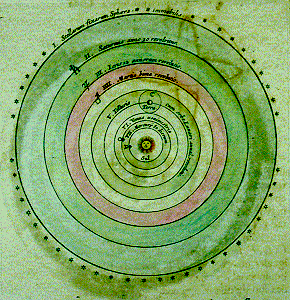
Within the practice of Ptolemaic astronomy there could be - and was - heated controversy about rival theories and conflicting representations of the astronomer's duty. But our simulation of Ptolemaic theorizing shows that the parameters of such debate were relatively narrowly fixed. Astronomy was a mathematical, "mixed" science, its practitioners attending to the quantitative representation and prediction of appearances rather than the reasoned analysis of natures and causes. When, in 1543, Nicolaus Copernicus's De Revolutionibus Orbium Coelestium (On the Revolutions of the celestial spheres) appeared, this had two major and conflicting consequences.

The Copernican system of the planets. Hand-colored illustration from a Spanish edition of Blaeu's Atlas, 1656. Courtesy of Caltech archives.
First, astronomers were able to make use of Copernicus's advanced mathematical techniques and models for the individual planets' appearances. In fact, Copernicus used theoretical devices and arguments that were thoroughly familiar to any trained Ptolemaic astronomer. Epicycles and deferents remained, as did the all-important faith in the circularity of planetary motions. His most important innovation was to disdain the use of equants, but even then he continued to refer the uniformity of motions, not to the Sun itself, but to an empty point in space. So, given that astronomers were not expected to make commitments as to the natural reality of their theoretical machineries, it was not hard for them to remain agnostic about Copernicus's moving Earth and use De Revolutionibus for their own purposes.
On the other hand, however, they were under no obligation to accept Copernicus's physical claims, and scarcely any did. Surveys of Renaissance astronomers have turned up only a dozen or so between Copernicus himself and Kepler in around 1600 who accepted heliocentrism as physically real. In this they were supported by Andreas Osiander's anonymous preface to De Revolutionibus itself, which downplayed Copernicus's allegiance and restated the traditional subordination of mathematical astronomy to natural philosophy. So the practice of Ptolemaic astronomy facilitated both use of Copernicus's work (where "use" meant application within an existing practical regime) and obliviousness to what a modern reader would regard as its outstanding argument.
Copernicus himself, however, was evidently far from oblivious to questions of physical reality. Readers who passed beyond Osiander's diplomatic preface - and the forbidding denial of entry to anyone unversed in geometry - found themselves facing a vehement denunciation of existing astronomy mounted with a full battery of humanist rhetorical weapons. He derided existing models in unfamiliar terms. Prevailing astronomical practices had failed, he announced, in three ways. They had provided no explanation for the constancy of the year - a period that recurred in all planets' models for no known reason. They produced inconsistency, with some schemes using solid spheres, some homocentric circles, and some a combination of epicycles and eccentrics. And they failed even to produce the quantitative accuracy that was supposedly their raison d'Ítre, some models being bluntly inaccurate, and others, by embracing the equant, violating "the first principle of uniformity in motion."
Most of all, however, Copernicus condemned "the mathematicians" for mistaking their subject. They had been entirely silent on what he called "the principal thing." Astronomers pursuing Ptolemaic methods had had nothing to say about "the shape of the universe," and about "the unchangeable symmetry of its parts." It was this that made their systems not just unsatisfactory but offensive, or, literally, "monstrous": "it is as though an artist were to gather the hands, feet, head, and other members for his images form diverse models, each part excellently drawn, but not related to a single body; since they in no way match each other, the result would be monster rather than man." In the end, the crime of Ptolemaic astronomy was that it paid no attention to the unity of the whole - or, in Copernicus's term, to its "symmetry."
We have seen in our simulation that Ptolemaic practice was simple and harmonious in one sense. It relied on a small set of mathematical tools, derived from the ancient mandate to account for planetary appearances in terms of regular circular motions. But Copernicus subjected it to a very different concept of symmetry, or harmony. He demanded that its system manifest unity across planetary models, such that major phenomena (the length of the year, the sequence of planets' speeds, retrograde motion) be produced as necessary results of its geometry. In a simple heliocentric system this need was met. By the standards of a Ptolemaic astronomer Copernicus's scheme was really no simpler than existing models, it was scarcely more accurate, and it embodied no major theoretical advance. So the prime criterion by which Copernicus's system might be definitively preferred did not exist within Ptolemaic practice.
Where it did exist was revealed in the pedigree that Copernicus provided for his arguments. Like all astronomical writers of the Renaissance and early modern period, Copernicus advanced an ancient source for his work. But Copernicus's authorities were not Aristotle and Ptolemy. They were, rather, Plato, Philolaus, Aristarchus, and Pythagoras. Together they manifested an alternative chronological descent of knowledge - of prisca sapientia, or ancient wisdom - and, in consequence, an alternative representation of knowledge itself. The Pythagoreans, Copernicus and others believed, had harboured insights into the harmonic structure of the world that they had kept hidden from the vulgar. Copernicus believed himself to have recovered some of their ancient wisdom, and suggested that he had pondered keeping it from the world at large on similar grounds.
Copernicus's advocacy, however, had its limits. Copernican astronomy as a technical practice differed little from the Ptolemaic enterprise. Only Kepler would give full voice to a neoplatonic astronomy that insisted on its right to adduce real archetypes, structures, and causes in the heavens. Meanwhile, the simulation here raises important questions about the perseverance of theoretical practices through even world-changing transformations in cosmology.
Site Map | Contact